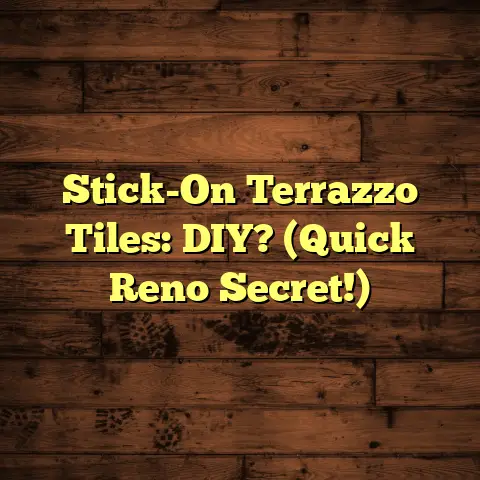Amtico Scratch Removal: Quick Fixes? (3 Minute Fix!)
Don’t worry, it’s not the end of the world. In this article, I’m going to walk you through some quick and easy fixes. Some of these can be done in under three minutes! Let’s get your floor looking its best again.
Section 1: Understanding Amtico Flooring
First, let’s talk about what Amtico actually is.
It’s a type of luxury vinyl tile (LVT). But it’s not your grandma’s vinyl! Amtico is designed to mimic the look of real wood, stone, or tile.
It does this with incredibly realistic textures and patterns.
It’s made up of multiple layers:
-
A backing layer: This provides stability.
-
A core layer: This is the main body of the tile.
-
A decorative layer: This gives it the realistic look.
-
A wear layer: This is the protective top coat that resists scratches and wear.
Amtico is a popular choice for homes and businesses because it’s:
- Durable: It can handle a lot of foot traffic.
- Water-resistant: Great for kitchens and bathrooms!
- Easy to clean: A simple sweep and mop usually does the trick.
- Stylish: It comes in a huge range of designs.
Even with that tough wear layer, scratches can still happen. It’s just the nature of having floors that are actually used. Think of it like this: even a diamond can be scratched, right?
Section 2: Types of Scratches on Amtico Flooring
Not all scratches are created equal. Knowing what kind you’re dealing with will help you choose the right fix. Here’s a breakdown:
-
Surface Scratches: These are light, hairline scratches that only affect the very top layer. You might see them as dull marks in the finish.
-
Deeper Scratches: These go through the wear layer and may even slightly damage the decorative layer. They’re more visible and might catch your fingernail.
-
Gouges: These are the worst! They’re deep cuts that remove material from the floor. These often require more serious repair.
To figure out what you’re dealing with, run your finger gently over the scratch. Can you barely feel it? It’s probably a surface scratch. Can you feel a definite groove? It’s likely a deeper scratch or a gouge.
Knowing the type of scratch is half the battle!
Section 3: Quick Fixes for Scratch Removal
Okay, let’s get to the good stuff! Here are some quick fixes you can try. Remember, these are best for those surface scratches or very minor deeper scratches.
Subsection 3.1: Using a Soft Cloth and Water
This is the simplest, and often the most effective, first step. Sometimes what looks like a scratch is just a scuff mark or dirt.
-
Dampen a soft, clean microfiber cloth with water. Make sure it’s not soaking wet. You don’t want to saturate the floor.
-
Gently rub the affected area. Use a circular motion.
-
Dry the area with another clean, dry cloth.
You’d be surprised how often this works! It’s like magic sometimes.
Subsection 3.2: Applying a Scratch Repair Kit
There are scratch repair kits specifically designed for LVT flooring. These usually contain a cleaning solution, a filler, and a sealant.
-
Clean the area: Use the cleaning solution provided in the kit. Follow the instructions on the bottle.
-
Apply the filler: This will fill in the scratch. Use a small amount and apply it evenly.
-
Let it dry: Follow the drying time recommended in the kit instructions. This is important!
-
Apply the sealant: This will protect the repaired area. Again, follow the instructions.
I’ve had good success with these kits, especially for those slightly deeper scratches.
Subsection 3.3: Using a Colored Wax Stick
Colored wax sticks are like crayons for your floor! They come in a variety of colors to match different flooring types.
-
Choose the right color: This is crucial! Try to find a wax stick that closely matches the color of your Amtico floor. You might need to blend two colors to get the perfect match.
-
Clean the area: Make sure the scratch is clean and free of debris.
-
Apply the wax: Rub the wax stick over the scratch, pressing firmly.
-
Remove excess wax: Use a plastic scraper or an old credit card to remove any excess wax. Scrape at a 45-degree angle to the scratch.
-
Buff the area: Use a soft cloth to buff the area and blend the wax into the surrounding floor.
This is a great option for hiding scratches, especially in patterned Amtico.
Subsection 3.4: Heat Treatment for Minor Scratches
This method uses heat to gently soften the wear layer and allow it to “self-heal” minor scratches. Be very careful with this method! Too much heat can damage your floor.
-
Gather your supplies: You’ll need a hairdryer, a soft cloth, and a heat-resistant pad or towel.
-
Protect the surrounding area: Place the heat-resistant pad or towel around the scratch to protect the rest of the floor.
-
Apply heat: Hold the hairdryer a few inches away from the scratch and apply heat for 30-60 seconds. Use a low heat setting!
-
Gently rub the area: Use the soft cloth to gently rub the area in a circular motion.
-
Let it cool: Allow the area to cool completely.
This works best on very minor surface scratches. I’ve seen it work wonders, but always test it in an inconspicuous area first!
Section 4: Preventative Measures
Okay, you’ve fixed your scratches. Now, how do you prevent them from coming back? Here are a few tips:
-
Use Furniture Pads: These are a must! Put them under the legs of all your furniture.
-
Regular Cleaning: Sweep and mop regularly to remove dirt and grit that can scratch the floor.
-
Choose Appropriate Footwear Indoors: Avoid wearing shoes with hard soles or high heels indoors.
-
Use Doormats: Place doormats at all entrances to trap dirt and debris before it gets tracked onto your floor.
-
Be Careful When Moving Furniture: Use furniture sliders or lift furniture instead of dragging it.
A little prevention goes a long way!
Section 5: When to Seek Professional Help
Sometimes, those quick fixes just aren’t enough. Here are some signs that you need to call in a professional:
- Deep Gouges: If you have deep gouges that can’t be filled with a wax stick or repair kit.
- Extensive Damage: If you have scratches over a large area of the floor.
- Loose or Damaged Tiles: If the scratch has caused the tile to become loose or damaged.
- You’re Unsure: If you’re not comfortable trying to repair the scratch yourself.
A professional flooring contractor can assess the damage and recommend the best course of action. This might involve replacing individual tiles or refinishing the entire floor.
Don’t be afraid to call in the pros. It’s better to be safe than sorry!
Conclusion
So, there you have it! Scratches on your Amtico floor don’t have to be a disaster. With a little bit of effort and the right techniques, you can keep your floor looking its best.
Remember, start with the simplest solutions first. You might be surprised at how effective a little water and a soft cloth can be.
Don’t be afraid to experiment with different methods to find what works best for you. And if all else fails, don’t hesitate to call in a professional.
Now, go forth and conquer those scratches! Your beautiful Amtico floor will thank you.
I’d love to hear about your experiences with Amtico scratch removal. Do you have any tips or tricks that you’d like to share? Let me know in the comments below!





